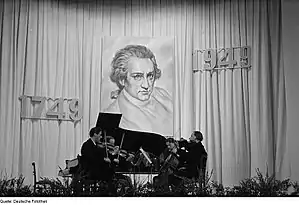Georg Hanstedt
Georg Hanstedt (9 October 1904 – 25 March 1975) was a German violinist. He was a long-standing member of the Gewandhaus Orchestra in Leipzig, and played in various string quartet formations. In 1934, he became a violinist of the Bayreuth Festival orchestra. He made recordings in the 1960s as second violin of the Schuster Quartet.
Georg Hanstedt | |
|---|---|
| Born | 9 October 1904 |
| Died | 25 March 1975 (aged 70) |
| Occupation | Classical violinist |
| Organization |
|
| Awards | Handel Prize |
Life
Hanstedt was born in 1904 in Gelsenkirchen as the son of a police station master, Georg Hanstedt, and his wife Elisabeth, née Wahnes.[1] After the Abitur passed at the secondary school in his home town, he studied[1] violin (with Walther Davisson and Hans Bassermann), teaching theory and composition (with Max Ludwig) at the Leipzig Conservatory from 1923 to 1928.[2]:440 In addition, he was enrolled at the University of Leipzig in humanities subjects.[1] He participated in the Gewandhaus concerts already during as a student.[1]
In 1929, he became a member of the second violins of the Gewandhaus Orchestra, conducted by Bruno Walter.[1] Following the emergency decree of Reich Chancellor Heinrich Brüning, he was dismissed in November 1931.[1] From October 1934, he played in the Leipziger Sinfonie-Orchester conducted by Hans Weisbach.[1] The same year, he was accepted by the Bayreuth Festival orchestra.[3]:138 In April 1937, he was reinstated in the Gewandhaus Orchestra, which was meanwhile conducted by Hermann Abendroth. He was drafted to the Wehrmacht in February 1943.[1] Until his release in Fürstenwalde in August 1945, he was a prisoner of war in the Soviet Union.[1] He then continued his activities in the Gewandhaus Orchestra with conductors Herbert Albert, Franz Konwitschny, Václav Neumann and Kurt Masur until 1971,[1] eventually playing first violin.[1]
Chamber music

Hanstedt was active as a chamber musician in many ways: From 1928 to 1938[2] he played second violin in the Genzel Quartet,.[4]:112 and in 1943 in the Schachtebeck Quartet,[4]:209 and from 1945 in the Kirmse Quartet.[2] Later, Hansted was second violin of the Schuster Quartet.[5]:3 In 1960, they recorded Max Butting's String Quartet No. 8, Op. 96.[6] They recorded in 1965/66 the String Quartet No. 2 by Leo Spies.[7] The quartet was awarded the Handel Prize in 1963.
From 1936 he was married to Irene Melzer; the couple had two children.[2] He died in Leipzig at age 70.
References
- Hans-Rainer Jung: Das Gewandhaus-Orchester. Seine Mitglieder und seine Geschichte seit 1743. Faber & Faber, Leipzig 2006, ISBN 3-936618-86-0, p. 222.
- Hedwig und Erich Hermann Mueller von Asow (ed.): Kürschners deutscher Musiker-Kalender 1954. 2nd edition of the Deutsches Musiker-Lexikon, de Gruyter, Berlin 1954.
- Alfred Sous: Das Bayreuther Festspielorchester. Geschichte, Geschichten und Anekdoten von damals bis heute on WorldCat Lienau, Berlin 1997, ISBN 3-87484-125-1.
- Jürgen Stegmüller: Streichquartett. Eine internationale Dokumentation zur Geschichte der Streichquartett-Ensembles und Streichquartett-Kompositionen von den Anfängen bis zur Gegenwart in: Quellenkataloge zur Musikgeschichte. Vol 40). Noetzel, Wilhelmshaven 2007, ISBN 978-3-7959-0780-8
- Hansjürgen Schaefer: Berliner Festtage 1957. Musik von Ottmar Gerster. Berliner Zeitung, 11 October 1957, Jg. 13, edition 238
- Eterna LP / 825800 bis 825899 (in German) liedderzeit.de 10 April 2020, retrieved 7 August 2020
- Rare Classical Recordings Episode 1 virtuosochannel.com retrieved 7 August 2020
External links
| Wikimedia Commons has media related to Georg Hanstedt. |
- Literature by and about Georg Hanstedt in the German National Library catalogue
- Georg Hanstedt discography at Discogs
- Georg Hanstedt on the MusicSack data base
- Leo Spies - String Quartet No. 2 (1963) on YouTube